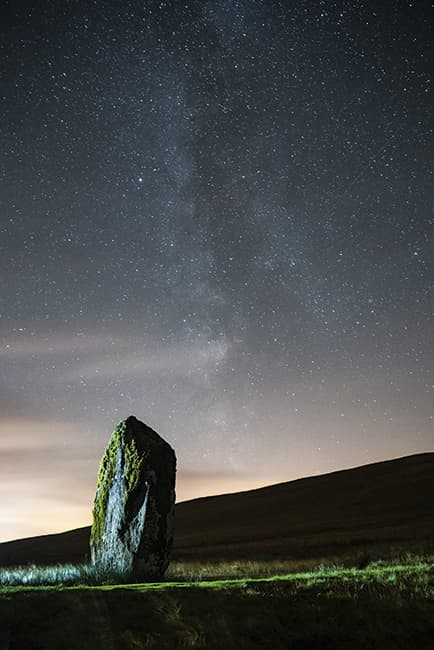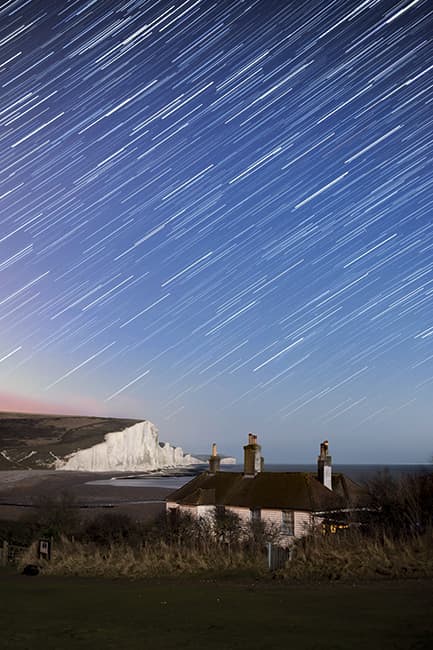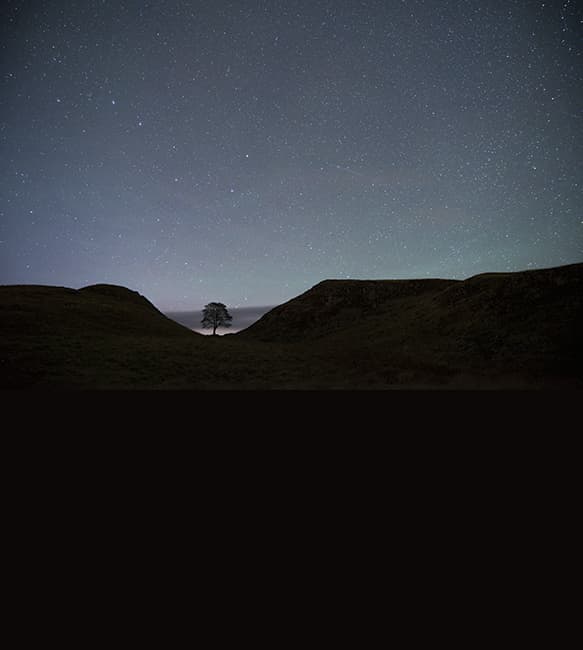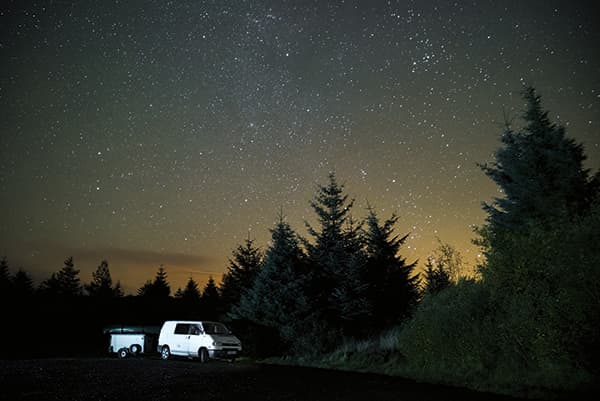If you’ve looked up on a clear night but never been in awe of the number of stars above you, chances are you’re an unwitting victim of light pollution.
Such is the extent of round-the-clock illumination and our widespread loss of true darkness that photographs depicting starscapes and the visible arc of the Milky Way are commonly assumed to have been fabricated in Photoshop, rather than being caught on camera.
Step away from the street lights, though, and there remain locations across the UK where it’s still possible to get a great view of our dynamic sky. Choosing to spend an evening chasing the dark is going to be antisocial at best, and it might also leave you tired and cold, but the results make it all worthwhile and the experience may just leave you starstruck.
Like many branches of photography, the work that goes into a successful wide-field astro image starts before you leave the house. I’m looking for scenes that let me convey the relationship between Earth and the stars. Researching and selecting locations based on local features and the quality of darkness is essential.
The earthly element could be anything from celestially aligned megaliths to the skeletal form of a decaying tree. In fact, almost any feature that can be silhouetted (or gently illuminated) against the starry backdrop will suffice.
The key to a purposeful image is gathering lots of starlight and that means using a wide aperture or high ISO settings – or both. While it’s cheaper to buy an extra stop of light via a fast prime lens than to upgrade your camera body, there’s no doubt that the high ISO performance of current models like the Sony Alpha 7S, which has a sensitivity range of ISO 40-409,600, is particularly well suited to low-light conditions. Such cameras provide a visible step up for low-light image quality, producing files with less noise and greater dynamic range for processing.

Cameras with high ISO noise performance, like the Sony Alpha 7S, are well suited to astrophotography
Exposure time
With settings of, say, f/2.8 and ISO 3200 to gather lots of starlight, the last factor of the exposure triangle is duration. Shutter speed controls the ambient light – the brightness of the sky – and it’s the shutter speed that gives me the most flexibility to work in range of conditions.
As the Earth rotates constantly, it doesn’t take long for stars to begin streaking within an image. Unless I’m specifically creating a star trail, I prefer to keep exposures as short as possible to retain the pinprick appearance of the stars. A wide aperture and a high ISO will always gather most starlight, but a scene that’s truly dark will need a much longer exposure to help define the foreground – 30secs or more than somewhere affected by light spill.
It’s not just streetlights that can brighten the scene. The moon also casts a lot of illumination, so it’s best to shoot when the sky is moonless. Clouds are another hindrance, especially thanks to the void between a meteorologist’s definition of clear skies and what we require as photographers.
That said, a wisp of cloud can add focus to an otherwise overwhelmingly starry sky. Personal taste will help you determine how much cloud you can tolerate. With the UK’s unpredictable climate, it already feels like a minor victory to be out beneath a clear sky. However, the challenges continue, as framing, focus and depth of field have yet to be overcome. At this point, a bright torch becomes an ally when shone towards the subject to give the camera’s autofocus something to bite on. While autofocus is not flawless, I’ve found that it’s either spot on or miles out. This makes it easy to confirm on the camera’s LCD, as opposed to manual focus, which can be slightly out and only becomes apparent when you look at an image on a big screen at home.
Framing
Depth of field needs consideration, but thanks to hyperfocal distance it is possible to shoot with a wide aperture and have both your foreground subject and backdrop of stars in sharp focus. For this, and for star-filled vistas in general, a wideangle lens is preferable. I’d suggest switching off any anti-shake systems as well.
My torch also helps me locate the bottom corners of my frame and check the foreground for unsightly elements. I have to remind myself when composing an image that the vast area of negative space above the horizon will be brought into play by the appearance of countless stars. Finally, with everything locked down on the tripod and a quick double check that the camera is set to record raw files, I can click my cable release to start the exposure.
I treat my first shot as a test. If it turns out well, it’s a bonus. Wide-field astrophotography needs a lot of trial and error, some intuition and a bit of luck. If my test looks too bright, I’ll shorten the exposure duration and reshoot. This dims the sky without drastically reducing the number of stars recorded, as I’m not changing the light sensitivity. If the test is too dark, usually I’ll push the ISO a little further to let in more light, without affecting depth of field or causing the stars to trail. At some point, though, a compromise is bound to arise. This is where it pays to know exactly what your camera is capable of, both on location and when its files reach the post-processing stage.
Meanwhile, luck will manifest as catching a meteor or, on rare occasions, experiencing aurorae. Neither can be reliably predicted, but setting up with the most light sensitivity provides the best chance of catching either.
Star trails
I’ve talked about keeping the stars as specks in the sky, but there are times when star trails can transform the shot. This is particularly the case if you’re able to include Polaris to the north, around which the other stars seem to circle.
For this effect, I set up with the same approach, but make sure continuous shooting mode is selected. It’s then just a case of locking the cable release in bulb mode to keep it firing, shot after shot. I tend to shoot star trails for an hour or longer, batteries permitting. I step back from the tripod and avoid using incidental torchlight when the camera’s running.

60x 20sec exposures (totalling 20mins) were ‘stacked’ to create this star-trail shot of the Seven Sisters in East Sussex
Back at my desk with a much-needed cup of tea, I load the files into Lightroom. Having spent time carefully setting up on location, most of my processing takes place via white balance, colour adjustments and a bit of noise reduction, though some shots need a little more work.
My preference is for images with integrity to the original scene, so I avoid pushing the contrast and clarity sliders too far. While they can certainly add impact, it’s often at the expense of image quality.
Why darkness matters

Every doubling of exposure duration is a doubling of ambient brightness. If you expose for longer, the static parts of your picture become brighter. With each star being of fixed brightness (although some are brighter than others), dim stars are very easily overpowered by ambient light, such as light pollution from street lamps and stray security lights. To further complicate matters, stars move through the sky so their brightness in any one place is finite.
The importance of ambient darkness is mirrored in the importance of choosing your settings. At the same location, an exposure at ISO 1600 and f/4 for 30secs would give you an image the same brightness as ISO 200 (3 stops less sensitive) and f/11 (3 further stops less sensitive) for 32mins (6 stops longer).
Despite the light levels being comparable, the appearance and mood of the two images would be vastly different, with the first shot featuring the presence of many tiny stars and the latter showing just a handful of extended star trails.
Why it works

A recent trip to Northumberland saw me well out of my local area, shooting with the Sony Alpha 7S. I’d researched what I could online, but there’s always the hope of stumbling upon something unexpected. A night watchman had steered me to this viewpoint, but rather than looking out over Kielder Water, I found the camper compelling.
Even without actual people, it reveals a sign of human activity that’s often absent from nocturnal images, while the scale of the camper versus the trees and night sky serves to highlight the part we play in the universe.
I laid my torch on a rock way out to the left of the frame to gently illuminate the van. Light from the torch also brought detail into the background, with the subsequent fir-green of the trees contrasting against the orange glow in the lower sky. It took careful white balancing to introduce this palette, offsetting the colour temperature of the LED torch against the rest of the scene. I just wonder why the camper residents, clearly outdoor types, weren’t alongside me, marvelling at the stars above?
For more tips, see more articles on astrophotography.








